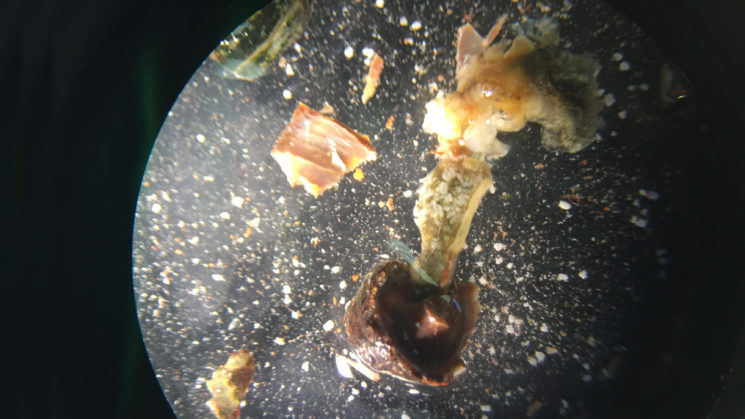
Above: A snail infected with larval trematodes. Centered under the lens, they resemble grains of rice.
BY CHRISTOPHER MOORE
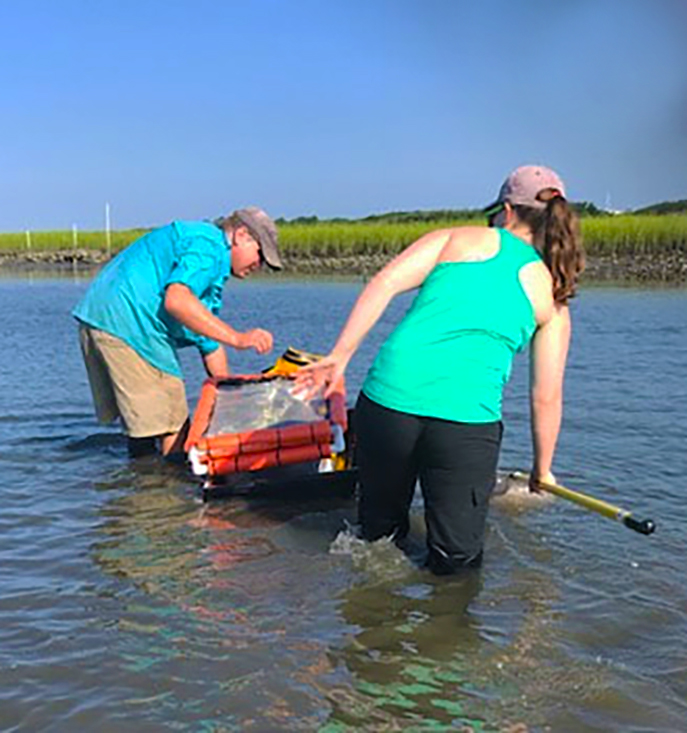 Christopher Moore is the 2018 North Carolina Coastal Research Fellow. North Carolina Sea Grant and the N.C. Coastal Reserve and National Estuarine Research Reserve Program jointly fund this fellowship, which supports research within one or more of the 10 sites that constitute the reserve. Moore, shown here on the left in the field with his colleague Rebecca Barnard, is a doctoral student in marine ecology at East Carolina University. He studies parasites as novel indicators of biodiversity in restored coastal habitats.
Christopher Moore is the 2018 North Carolina Coastal Research Fellow. North Carolina Sea Grant and the N.C. Coastal Reserve and National Estuarine Research Reserve Program jointly fund this fellowship, which supports research within one or more of the 10 sites that constitute the reserve. Moore, shown here on the left in the field with his colleague Rebecca Barnard, is a doctoral student in marine ecology at East Carolina University. He studies parasites as novel indicators of biodiversity in restored coastal habitats.
Parasites have an image problem. Google “parasites,” and you will get nearly 50 million results, many of which are disturbing from a human health standpoint.
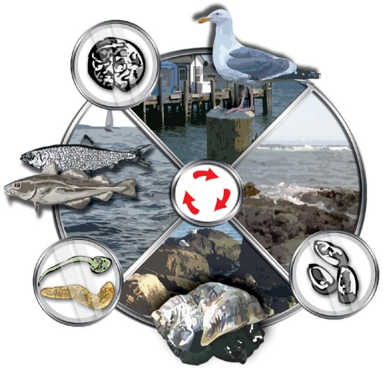
The Trematode Parasite utilizes multiple hosts to complete its lifecycle, typically starting with snails, where the trematode reproduces asexually, creating numerous cercariae, free-swimming larvae. These cercariae are shed from the snail and next seek out and encyst as metacercariae in a second-intermediate host (e.g., fish, crustaceans, worms). The trematode’s second host is then ingested by a definitive vertebrate host, often a bird or fish, where sexual reproduction occurs, and the trematode’s eggs are deposited into the marine environment with the hosts’ feces. Grazing snails may ingest these eggs, and the cycle continues. Courtesy of A.M.H Blakeslee and R. Houghton.
However, the situation is much different if we search the scientific literature and think of these organisms from an ecological point of view. By some estimates, as much as 40 percent of the world’s biodiversity is parasitic.
Many parasites, moreover, are highly specialized and require multiple hosts, spanning much of the animal kingdom, to complete their lifecycles. In coastal systems, these hosts are often organisms like snails, crabs, fish, birds, reptiles and mammals. Given their connections to multiple hosts, these parasites can be thought of as representing the links between organisms in an ecosystem. Although it may seem counterintuitive, a healthy environment is, in fact, rich in parasites because the hosts that parasites need are also present in the system. On the other hand, if the hosts are not present, then the parasites that need those hosts will not be present either.
Because of the links that parasites form with their hosts, parasites have the potential to serve as indicators for monitoring biodiversity in marine ecosystems. I am testing this hypothesis at the Rachel Carson National Estuarine Research Reserve in Beaufort, North Carolina.
Portions of the Reserve have experienced significant shoreline erosion, and these areas were recently restored using bags of oyster shell and novel “oyster catcher” structures made of a latticework of concrete-wrapped burlap. While both techniques are capable of mitigating erosion, we are interested in determining if some methods are more effective at enhancing biodiversity over time, particularly for organisms like fish, birds, and reptiles like diamondback terrapins, which can be elusive and difficult to sample. As unlikely as it seems, parasites are our partners in these restoration efforts, providing clues that tell us those other organisms are in the general area.
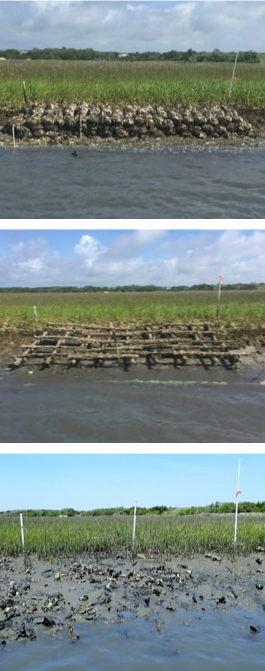
Shorelines in the Rachel Carson Reserve have been restored with bags of oyster shell (top), oyster catcher material (middle), and no-restoration control treatments (bottom).
We sample for parasites in easily-collected hosts like eastern mudsnails (Tritia obsoleta), panopeid mud crabs, and small fishes like naked gobies (Gobiosoma bosc), striped blennies (Chasmodes bosquianus), skilletfish (Gobiesox strumosus) and oyster toadfish (Opsanus tau). All of these hosts are relatively sedentary, which is important because we hypothesize that parasite diversity in these organisms will correlate with specific areas of shoreline within the reserve. Mud snails, for instance, are parasitized by nine different digenetic trematodes (a type of parasitic flatworm), each requiring a unique combination of hosts to complete its lifecycle (Table 1, below).
By repeatedly sampling for these parasites at our restoration sites, we can get an idea of the number and types of additional hosts, based on the species of trematodes we find and the combination of hosts that each species requires. For example, if we are finding a high abundance of larval trematodes like Gynaecotyla adunca or Pleurogonius malaclemys, we can infer that the final hosts these parasites require (shorebirds and diamondback terrapins, respectively) are also using these restored sites as habitat.
Our preliminary data show that habitat complexity enhances overall biodiversity, as both host and parasite diversity are higher in areas with natural marsh. It is too early to determine how parasite diversity is affected by habitat improvement at Carrot Island, though. Restoration was completed in May, and we are in the early stages of post-restoration monitoring. However, it has been said that “home is where the habitat is,” and we anticipate that parasite diversity will increase with time as additional hosts accumulate in areas with restored habitat.
My advisor, April Blakeslee at East Carolina, and I expect to continue our work over the next few years to obtain an understanding of how long it takes for the full complement of hosts to return to a site following restoration. With our collaborators, Rachel Gittman at ECU and Brandon Puckett at the NC Coastal Reserve, we will also survey additional sites that have been restored within the last 20 years to look at the long-term influence of restoration on parasite diversity.
By harnessing the multiplicity of links that parasites form in an ecosystem, we can use parasite diversity as a tool to inform and guide restoration projects. Perhaps, too, we can change the way people think about these ubiquitous and fascinating organisms.
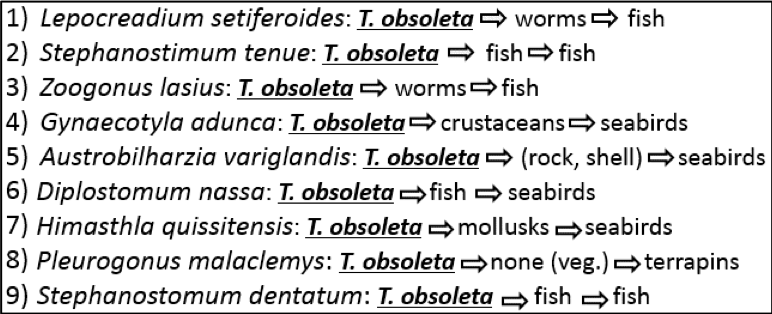
Table 1: Nine species of trematodes parasitize the common mudsnail Tritia obsoleta. Each species requires a unique combination of downstream hosts to complete its lifecycle. Courtesy of A.M.H. Blakeslee.